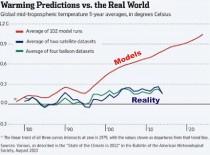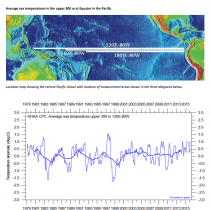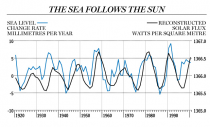The Supreme Court decided against EPA’s rule to limit trace emissions of mercury and other substances from power plants.
This is good news.
The Court held that EPA failed to perform a meaningful cost-benefit analysis in promulgating the rule. Justice Antonin Scalia, writing for the majority, held that, “EPA strayed well beyond the bounds of reasonable interpretation in concluding that cost is not a factor relevant to the appropriateness of regulating power plants.”
This rule has been termed the costliest regulation ever. It has already caused damage to our economy and, if fully implemented, could be even more devastating.
Professor Willie Soon and CFACT senior policy advisor Paul Driessen co-authored an article regarding the EPA’s mercury rule that provides valuable perspective. In it they note:
“The latest government, university and independent studies reveal that those power plants emit an estimated 41-48 tons of mercury per year. However, U.S. forest fires emit at least 44 tons per year; cremation of human remains discharges 26 tpy; Chinese power plants eject 400 tpy; and volcanoes, subsea vents, geysers and other sources spew out 9,000-10,000 additional tons per year!”
All these emissions enter the global atmospheric system and become part of the U.S. air mass.
Thus, U.S. power plants account for less than 0.5% of all the mercury in the air Americans breathe. Even eliminating every milligram of this mercury will do nothing about the other 99.5% in America’s atmosphere.”
You can read it in its entirety here.
As several news sources note, this Supreme Court ruling could also have implications for the President’s forthcoming plans to limit carbon emissions. Let’s hope it does -
Especially for the sake of working families and the poor.
The National Black Chamber of Commerce just released a study concluding EPA’s power plant carbon rule “would increase black poverty by 23 percent and cause the loss of 7 million jobs for black Americans by 2035.” The study also found that the EPA’ plan “would increase Hispanic poverty by 26 percent and cause the loss of 12 million jobs for Hispanic Americans by 2035.”
Of course, EPA may try to re-promulgate its mercury rule with a cost-benefit analysis attached. If that analysis is done honestly, the rule will be exposed for the mistake it is.
In the meantime, we have reason to be pleased with this Supreme Court ruling. It provides some good news headed into the 4th of July.
For nature and people too,
Craig Rucker, Executive Director
NOTE: Seeking ALPHA comments: Coal stocks are rallying after the Supreme Court threw out the EPA’s first-ever rules requiring coal-fired power plants to cut emissions of mercury and other toxic air pollutants, saying the agency should have weighed the cost of compliance in deciding whether to regulate.The ruling means the EPA must go back to the drawing board, which possibly could push any new emissions rules past Pres. Obama’s time in office.
----------
U.S. Supreme Court Ruling Spells Trouble For Obama’s Climate Agenda
Clare Foran
Monday’s ruling could compel agencies to take costs into account when deciding to regulate.
President Obama has made it clear that his Environmental Protection Agency will use its regulatory power to install limits on carbon dioxide and toxic-air pollutants for everything from power plants to trucks.
But Monday’s Supreme Court decision against EPA is a reminder that the biggest threat to Obama’s green legacy and the sweeping regulatory agenda that the administration is racing to cement before the president leaves office comes from the courts.
The 5-4 decision, with the majority opinion penned by Justice Antonin Scalia, ruled that EPAviolated the law by failing to consider cost in deciding to regulate toxic-air pollution from power plants. That verdict is a setback to the administration at a time when all hands on deck are needed to defend the president’s climate agenda.
It creates uncertainty over the fate of a key pillar of the president’s efforts to curb air pollution and hands a fresh set of talking points to opponents of the rule as they argue that the administration overreached.
The biggest impact, however, may be felt down the road - and across the entire federal government.
Some legal experts contend that the ruling could send a message to federal agencies that they must demonstrate that they have taken cost into account when deciding to regulate - and that if an agency ignores cost, it does so at its own peril.
“This is a groundbreaking administrative-law case,” said Justin Savage, a former Justice Department environmental lawyer who served under the administrations of George W. Bush and Obama and a partner with the law firm Hogan Lovells. “It essentially says that when a statute is ambiguous an agency must consider costs.”
“The reason I’m struck by this and a bit troubled is that there’s a real question of whether this decision applies broadly. And I read it as applying broadly,” said Lisa Heinzerling, a Georgetown law professor and senior climate-policy counsel to former EPA Administrator Lisa Jackson.
If that precedent sticks, it could throw a wrench into the gears of the regulatory machine if agencies must devote additional time and resources making sure their cost calculations hold up in court.
“After this decision, an agency would not want to walk into court saying, ‘Your Honor, we did not consider costs at all when deciding to take regulatory action on an issue,’” said Jonathan Adler, an environmental law professor at Case Western Reserve University.
Even if the court decision does not set such a precedent, Republicans and industry challengers say Monday’s verdict proves that the administration overstepped the limits of the law.
“The mere fact that the EPA wished to ignore the costs of its rules demonstrates how little the agency is concerned about the effects it has on the American people,” House Majority Leader Kevin McCarthy said after the ruling was handed down. “From its ozone, to greenhouse gas, to navigable waters rules, the EPA continues to burden the public with more and more costs, even as so many are still struggling to get by and improve their lives in this economy.”
The Supreme Court’s decision to side against the agency also serves as a painful reminder to the administration that it may not always see its regulatory actions upheld in the face of legal challenges.
----------
As usual, NOAA climate ‘scientists’ view tropical ocean temperatures with AGW biases
Due to a significant warming trend in the Nino-3.4 region since 1950, El Nino and La Nina episodes that are defined by a single fixed 30-year base period (e.g. 1971-2000) are increasingly incorporating longer-term trends that do not reflect interannual ENSO variability. In order to remove this warming trend, CPC is adopting a new strategy to update the base period.
The reality is the NINO34 has not changed at all since 1979. Most of the so called warming occurred in the Great Pacific Climate Shift in 1977 which moved the Pacific from a cold mode (cold PDO) favoring La Ninas to the warm phase (warm PDO) favoring El Ninos.
Global monthly sea surface temperature (SST) in the Nino 3.4 region (5N-5S, 170W-120W) of the central Pacific Ocean since 1979 according to the National Oceanographic and Atmospheric Administration (NOAA) Climate Prediction Center. Last month shown: May 2015. Last diagram update: 4 June 2015.

Enlarged
The Pacific ocean down to 300 meters in the entire stretch from 130E to 80W showed no warming in that period.
The tropical hot spot as shown in all greenhouse models where CO2 allegedly traps heat and warms the high atmosphere with the boosting effect of condensation from enhanced convection in an assumed moistened state is absent in both weather balloon and satellite data. This in turn is supposed to radiate down to warm the surface and oceans in the models. These failures along with the lack of warming for over 18.6 years in satellite and balloon data should totally invalidate the theory. Instead under pressure from ideologially driven politicians and green NGOs, the advocates spend much of ther time trying to find the hidden warming and adjusting data to make it seem to fit the theory.

Enlarged
The many excuses for the so called ‘pause’ NOAA’s failed effort to erase are comical. The heat is hidden in the oceans is belied by the fact that a warming of the deep oceans would accelerate sea level rise and instead the sea levels rises have slowed to between 4 and 7 inches/century. The solar cycles and the changes of the many solar factors shows a perfect fit to sea level changes (Nir Shaviv ) .
--------
Fiddling with the data
David Rothbard

What could be more embarrassing for those who say climate science is “settled” than for scientific observations to reveal their dire predictions are not coming true?
Every day more scientific data emerge that poke cavernous holes into the warming narrative, and maybe that’s why some in the warmist camp are willing to tinker with the evidence.
Disturbingly, NOAA recently made a shoddy attempt to conjure up a 21st century “warming trend” by ignoring satellite data (the best available), and adjusting measurements from research buoys upward to match data from shipping, which is the least reliable.
Fortunately they didn’t get away with it.
Climatologists Pat Michaels, Richard Lindzen, and Chip Knappenberger were onto them. They pointed out that “the NOAA team adjusted sea-surface temperature (SST) data from buoys upward by 0.12C, to make them ‘homogenous’ with lengthier records from engine intake systems in ships. However, engine intake data are ‘clearly contaminated by heat conduction’ from the ships, and the data were never intended for scientific use -whereas the global buoy network was designed for environmental monitoring.”
So why not adjust the ship data downward, to “homogenize” them with buoy data, and account for the contamination? Perhaps because, as Georgia Tech climatologist Judith Curry observed, this latest NOAA analysis “will be regarded as politically useful for the Obama Administration.”
Global warming pressure groups and the White House hope to keep our eyes off inconvenient data, either by manipulating it or distracting us with scare stories in the media, until after President Obama signs our energy future away at the UN climate conference in Paris.
Unfortunately for them, facts are facts.
The Earth is actually cooler than climate models project and the weather is normal. Extreme weather, as the data show, has been unusually tame.
Energy expert Tom Tamarkin and CFACT senior policy advisor Paul Driessen have also done their part to expose some of the propaganda tricks being played by Green advocates to lock the world’s nations into a UN climate agreement while President Obama is still in office.
In their recent article, Tamarkin and Driessen remind us that, “no category 3-5 hurricane has hit the United States for a record 9-1/2 years. Tornadoes, droughts, polar bears, polar ice, sea levels and wildfires are all in line with (or improvements on) historic patterns and trends. The Sahel is green again, thanks to that extra CO2. And the newly invented disasters they want to attribute to fossil fuel-driven climate change - allergies, asthma, ISIS and Boko Haram - don’t even pass the laugh test.”
Of course, the very notion of “settled” science is a direct contradiction of the scientific method.
If the data disprove a theory, the theory must change.
Shame on those who are trying to bend the rules.





